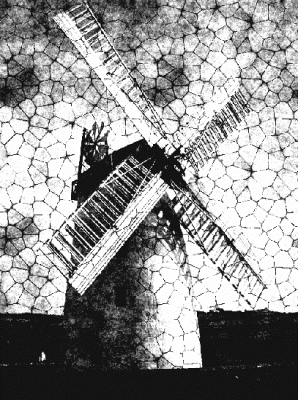Quick links to procedures on this page:
You can apply the Express Texture to generate a high-contrast version of an image in grayscale, which creates a visual effect similar to a custom halftone screen, like a mezzotint or line screen. When you use this effect, anti-aliasing is automatically applied to the image.
You need to choose a method for applying the effect. There are five different methods for applying Express Texture:
| • |
Paper — adjusts light intensity by using the paper texture as a mapping model. If you want to experiment with the effect, keep the Papers panel open while you apply the effect. This way you can switch to different papers and modify the paper controls. |
| • |
Image Luminance — uses the image’s brightness as the model for the adjustments |
| • |
Original Luminance — uses the luminance of the clone source as the model for the adjustment |
| • |
Alpha Channel or Layer Mask — sets the values in the alpha channel or layer mask as the model for the adjustments. You can use this method only if you have a saved channel or a layer mask in your image. |
An image with the Express Texture effect applied
|
2
|
Choose Effects  Surface Control Surface Control  Express Texture. Express Texture. |
|
3
|
Choose Image Luminance from the Using list box. |
|
1
|
Choose Window  Paper Panels Paper Panels  Papers. Papers. |
|
4
|
Choose Effects  Surface Control Surface Control  Express Texture. Express Texture. |
|
5
|
Choose Paper from the Using list box. |
|
• |
To use a clone source, choose Window  Clone Source. In the Clone Source panel, click the Open Image button Clone Source. In the Clone Source panel, click the Open Image button  , and Open Source to choose a clone source. , and Open Source to choose a clone source. |
|
• |
To use a pattern, choose Window  Media Library Panels Media Library Panels  Patterns, and click a pattern swatch from the Pattern library panel. Patterns, and click a pattern swatch from the Pattern library panel. |
|
3
|
Choose Effects  Surface Control Surface Control  Express Texture. Express Texture. |
|
4
|
Choose Original Luminance from the Using list box. |
|
2
|
Choose Effects  Surface Control Surface Control  Express Texture. Express Texture. |
| • |
Gray Threshold — determines where the threshold is, between pure black and pure white |
| • |
Grain — determines how deeply the texture penetrates the surface |
| • |
Contrast — determines the number of levels of black and white. For example, low contrast generates pure gray, medium contrast produces levels of grayscale, and high contrast produces a black and white screen. |
Copyright 2017 Corel Corporation. All rights reserved.

 , and Open Source to choose a clone source.
, and Open Source to choose a clone source.